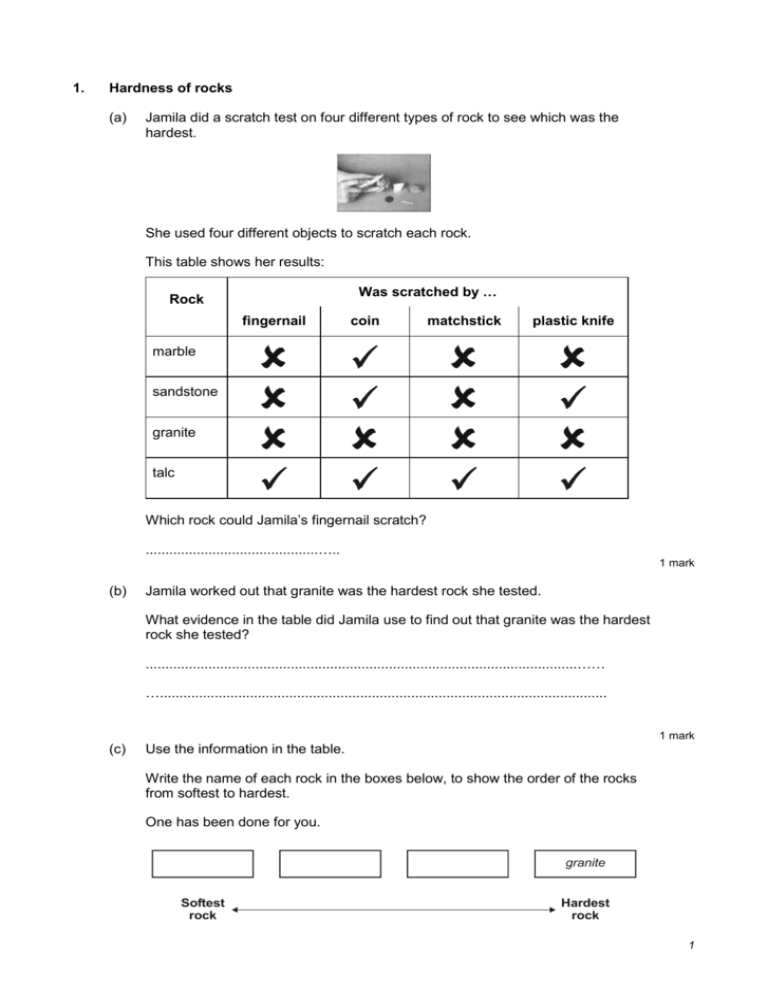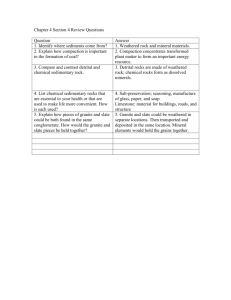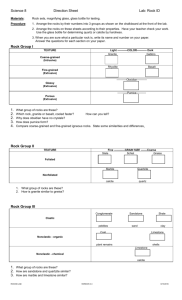Rocks
advertisement

1. Hardness of rocks (a) Jamila did a scratch test on four different types of rock to see which was the hardest. She used four different objects to scratch each rock. This table shows her results: Was scratched by … Rock fingernail coin matchstick plastic knife marble sandstone granite talc Which rock could Jamila’s fingernail scratch? ............................................….. 1 mark (b) Jamila worked out that granite was the hardest rock she tested. What evidence in the table did Jamila use to find out that granite was the hardest rock she tested? ..............................................................................................................…… ….................................................................................................................. 3 1 mark (c) Use the information in the table. Write the name of each rock in the boxes below, to show the order of the rocks from softest to hardest. One has been done for you. granite Softest rock Hardest rock 1 1 mark (d) As Jamila was doing her test, she realised it was hard to keep her test fair. Tick ONE box to show why it was hard for Jamila to keep her test fair. The rocks were different sizes. The shapes of the objects were different. Some of the objects were harder than others. It was difficult to scratch each rock with the same force. 1 mark (e) Jamila carries out some more tests on her rocks. She uses the table below to record the new information she learns from her tests. Feels rough Permeable Not permeable sandstone granite talc marble Does not feel rough Use the information from the table to write TWO new things Jamila learnt about granite. 1. ................................................................................................................. 2. ................................................................................................................. 1 mark 2. Examining rocks (a) Paul has four pieces of rock: granite slate sandstone limestone He slowly drops some water onto each rock. A small amount of water soaks into some of the rocks. 2 Which of these words describes a rock that water soaks into? Tick ONE box. translucent flexible permeable opaque 101 mark (b) Paul tests the rocks for hardness. He uses each rock to try to make a scratch on the other rocks. He records his results in a table. Rock used Did it leave a scratch... on slate? on limestone? on granite? on sandstone? yes no yes no no slate limestone no granite yes yes sandstone no yes yes no Use the table to answer these questions. Which rocks did the slate scratch? ...................................................................................................................... 1 mark (c) Which rock was the hardest? ...................................................................................................................... 1 mark (d) Use the information in the table to explain how you know this was the hardest rock. ...................................................................................................................... ...................................................................................................................... 1 mark 3 3. Acid rain (a) Sometimes rain mixes with pollution in the air to form acid rain. Some children want to find out what happens when acid rain falls on rocks. Vinegar can be used to show the effects of acid rain. The children add vinegar to chalk rock. The pictures below show what happens. bubble vinegar dish Chalk rock Chalk rock and vinegar Bubbles are produced. Write true or false next to each sentence below. The change is non-reversible. ............................................... The bubbles evaporate. ............................................... 1 mark (b) Write solid, liquid or gas next to each material in the table. Material Solid, liquid or gas? inside the bubble vinegar chalk rock 1 mark (c) The children test more rocks. The table below shows their results. Rock Are bubbles produced when vinegar is added? granite no sandstone no limestone yes slate no pumice yes Look at these pictures of a statue. The statue is in a city that has acid rain. 4 Statue when new Same statue after 200 years Use the table to name ONE rock that this statue could have been made from. ............................................... 1 mark 4. Soil (a) Children put four different types of soil into funnels. They poured 300 cm³ of water on to each soil. They measured how much water passed through in five minutes. Look at the picture. Which soil allowed the least water to pass through it? Tick ONE box. 1 mark (b) Clay has small particles and does not let water through easily. Sand has larger particles and lets water through easily. The table shows the four types of soil they tested. Which type of soil was put in each funnel? Complete the table by writing the letter for each funnel? soil funnel all clay mostly clay, some sand mostly sand, some clay all sand 1 mark 5 (c) The children showed their results on a graph. The graph shows how much water each type of soil let through in five minutes. 300 250 200 volume of water 150 in cm³ 100 50 0 soil A soil B soil C soil D small stones soil type The children then poured 300 cm³ of water onto small stones in a funnel. Draw a bar on the graph to predict the volume of water which will pass through the small stones in five minutes. 1 mark (d) Marram grass grows in very sandy places. Explain how the long roots of the marram grass help it to survive in very sandy places. ...................................................................................................................... ...................................................................................................................... 1 mark 5. Rock pool (a) Some children see four living things in a rock pool. Which ONE of these living things is a producer in a food chain? .............................................................................................................1 mark 6 (b) Some sea water is trapped in the rock pool. The water cannot drain away. Which word best describes the rock that stops the water draining away? Circle ONE word. permeable impermeable strong rough absorbent 1 mark 6. Rocks (a) Sally investigated some rocks. She recorded her observations. observation rock can it be scratched with a knife? does it let water through? can it be split into flat pieces? sandstone yes yes no granite no no no slate yes no yes marble yes no no Look at the table. Which rock cannot be scratched with a knife? ...................................................................................................................... 1 mark (b) She sorted all the rocks by permeability. Look at the table. Write the names of the rocks in each group. permeable not permeable 1 mark 7 (c) Next she sorted them like this. sandstone granite marble slate Group A Group B Look at the table. Describe why the rocks in group A make a group. ...................................................................................................................... 1 mark 8





